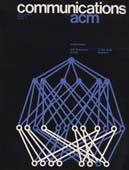December 1978 - Vol. 21 No. 12

Features
Using encryption for authentication in large networks of computers
Use of encryption to achieve authenticated communication in computer networks is discussed. Example protocols are presented for the establishment of authenticated connections, for the management of authenticated mail, and for signature verification and document integrity guarantee. Both conventional and public-key encryption algorithms are considered as the basis for protocols.
A linear sieve algorithm for finding prime numbers
A new algorithm is presented for finding all primes between 2 and n. The algorithm executes in time proportional to n (assuming that multiplication of integers not larger than n can be performed in unit time). The method has the same arithmetic complexity as the algorithm presented by Mairson [6]; however, our version is perhaps simpler and more elegant. It is also easily extended to find the prime factorization of all integers between 2 and n in time proportional to n.
The selection of optimal tab settings
A new generation of computer terminals allows tab settings to be selected and set by the computer. This feature can be used to reduce the number of characters that are needed to represent a document for transmission and printing. In this note, an algorithm is given for selecting the optimal set of tab stops for minimizing the number of characters transmitted. An implementation of the algorithm has reduced the number of characters transmitted by from 7 to 30 percent, but requires a prepass through the document to compute a matrix used in determining the optimal set of tab stops. The use of fixed tab stops, as a heuristic alternative, can achieve about 80 percent of optimal with no prepass.
The findings of a study designed to address the pressing problems associated with the strategic planning of the computing effort in higher education are presented here. A planning methodology was developed and tested through implementation at a university. Two years after the methodology was implemented, the effectiveness of the planning methodology was assessed in terms of the improvement of the delivery of computing services to the major institutional roles of instruction, research, and administration. Two control institutions were employed to contrast the improvements at the test institution. The results of the research indicate the planning methodology significantly enhanced the delivery of computing services.
Detection of logical errors in decision table programs
In this paper an algorithm to detect logical errors in a limited-entry decision table and in loop-free programs with embedded decision tables is developed. All the conditions in the decision tables are assumed to be inequalities or equalities relating linear expressions. It is also assumed that actions in a decision table are linear in variables which occur in the condition stub of the decision table (or tables) to which control is transferred from the table. The algorithm is based on determining whether a set of linear inequalities has or does not have a solution. The algorithm described in the paper is implemented in Fortran IV.
Optimizing decision trees through heuristically guided search
Optimal decision table conversion has been tackled in the literature using two approaches, dynamic programming and branch-and-bound. The former technique is quite effective, but its time and space requirements are independent of how “easy” the given table is. Furthermore, it cannot be used to produce good, quasioptimal solutions. The branch-and-bound technique uses a good heuristic to direct the search, but is cluttered up by an enormous search space, since the number of solutions increases with the number of test variables according to a double exponential. In this paper we suggest a heuristically guided top-down search algorithm which, like dynamic programming, recognizes identical subproblems but which can be used to find both optimal and quasioptimal solutions. The heuristic search method introduced in this paper combines the positive aspects of the above two techniques. Compressed tables with a large number of variables can be handled without deriving expanded tables first.
Reverse path forwarding of broadcast packets
A broadcast packet is for delivery to all nodes of a network. Algorithms for accomplishing this delivery through a store-and-forward packet switching computer network include (1) transmission of separately addressed packets, (2) multidestination addressing, (3) hot potato forwarding, (4) spanning tree forwarding, and (5) source based forwarding. To this list of algorithms we add (6) reverse path forwarding, a broadcast routing method which exploits routing procedures and data structures already available for packet switching. Reverse path forwarding is a practical algorithm for broadcast routing in store-and-forward packet switching computer networks. The algorithm is described as being practical because it is not optimal according to metrics developed for its analysis in this paper, and also because it can be implemented in existing networks with less complexity than that required for the known alternatives.
Abstract data types and software validation
A data abstraction can be naturally specified using algebraic axioms. The virtue of these axioms is that they permit a representation-independent formal specification of a data type. An example is given which shows how to employ algebraic axioms at successive levels of implementation. The major thrust of the paper is twofold. First, it is shown how the use of algebraic axiomatizations can simplify the process of proving the correctness of an implementation of an abstract data type. Second, semi-automatic tools are described which can be used both to automate such proofs of correctness and to derive an immediate implementation from the axioms. This implementation allows for limited testing of programs at design time, before a conventional implementation is accomplished.
An example of hierarchical design and proof
Hierarchical programming is being increasingly recognized as helpful in the construction of large programs. Users of hierarchical techniques claim or predict substantial increases in productivity and in the reliability of the programs produced. In this paper we describe a formal method for hierarchical program specification, implementation, and proof. We apply this method to a significant list processing problem and also discuss a number of extensions to current programming languages that ease hierarchical program design and proof.



